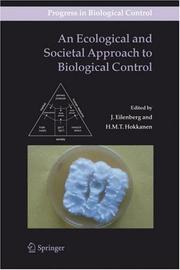| Listing 1 - 10 of 12 | << page >> |
Sort by
|

ISBN: 1280624949 9786610624942 1402044011 1402043201 Year: 2006 Publisher: Dordrecht ; [Great Britain] : Springer,
Abstract | Keywords | Export | Availability | Bookmark
 Loading...
Loading...Choose an application
- Reference Manager
- EndNote
- RefWorks (Direct export to RefWorks)
Biological control is among the most promising methods for control of pests (including vectors), diseases and weeds. In this book ecological and societal aspects are for the first time treated together. In an ecological approach the aim is to evaluate the significance of certain biological properties like biodiversity and natural habitats. Also, it is important to see biological control from an organic (or ecological) farming point of view. In a societal approach terms like ‘consumer’s attitude’, ‘risk perception’, ‘learning and education’ and ‘value triangle’ are recognised as significant for biological production and human welfare.
Pests --- Weeds --- Biological control. --- Bio-control of weeds --- Biocontrol of weeds --- Biological control of weeds --- Weed biocontrol --- Weed biological control --- Bio-control of pests --- Biocontrol of pests --- Biological control of pests --- Biological pest control --- Biological pest control agents --- Control
Book
ISBN: 0521473535 Year: 1995 Publisher: Cambridge : Cambridge university press,
Abstract | Keywords | Export | Availability | Bookmark
 Loading...
Loading...Choose an application
- Reference Manager
- EndNote
- RefWorks (Direct export to RefWorks)
Agricultural pests --- Biological pest control agents --- Biological control --- Congresses. --- Congresses.
Digital
ISBN: 9789048124657 Year: 2009 Publisher: Dordrecht Springer Netherlands
Abstract | Keywords | Export | Availability | Bookmark
 Loading...
Loading...Choose an application
- Reference Manager
- EndNote
- RefWorks (Direct export to RefWorks)
Book
Abstract | Keywords | Export | Availability | Bookmark
 Loading...
Loading...Choose an application
- Reference Manager
- EndNote
- RefWorks (Direct export to RefWorks)
Oryza sativa --- Oryza sativa --- Zea mays --- Zea mays --- Lycopersicon esculentum --- Lycopersicon esculentum --- Cereals --- Cereals --- oil crops --- oil crops --- Ornamental plants --- Ornamental plants --- Drug plants --- Drug plants --- Root crops --- Root crops --- Transgenic plants --- Transgenic plants --- Plant biotechnology --- Plant biotechnology --- genetic engineering --- genetic engineering --- Herbicides --- Herbicides --- Resistance to chemicals --- Resistance to chemicals
Book
ISBN: 0511661738 Year: 1995 Publisher: Cambridge : Cambridge University Press,
Abstract | Keywords | Export | Availability | Bookmark
 Loading...
Loading...Choose an application
- Reference Manager
- EndNote
- RefWorks (Direct export to RefWorks)
Biological control of insect pests, plant pathogens and weeds, is the only major alternative to the use of pesticides in agriculture and forestry. As with all technologies, there are benefits and risks associated with their utilization. This book is the outcome of a unique gathering of specialists to discuss and debate the benefits and risks associated with biological control. After intensive interaction it was concluded that we must place greater emphasis on the benefits, while not ignoring the potential risks. The authors address the various techniques and approaches used in biological control, including state-of-the-art reports and economic and risk analyses. The book will be of interest to researchers and postgraduate students in academia and industry in biotechnology, agriculture, forestry and environmental sciences.
Agricultural pests --- Biological pest control agents --- Biological control

ISBN: 9780511661730 9780521473538 9780521544054 Year: 1995 Publisher: Cambridge Cambridge University Press
Abstract | Keywords | Export | Availability | Bookmark
 Loading...
Loading...Choose an application
- Reference Manager
- EndNote
- RefWorks (Direct export to RefWorks)
Book
ISBN: 2876713071 9782876713079 Year: 1998 Publisher: Paris Frison-Roche
Abstract | Keywords | Export | Availability | Bookmark
 Loading...
Loading...Choose an application
- Reference Manager
- EndNote
- RefWorks (Direct export to RefWorks)
Si l'on en croit les porte-parole des multinationales engagées dans le génie génétique, l'humanité pourra bientôt, grâce à leur technologie miracle, résoudre le problème de la faim dans le monde et contribuer à la préservation de l'environnement en réduisant l'usage des pesticides.Selon eux, les risques pour l'environnement et la santé humaine sont nuls ou négligeables ; les perspectives économiques et sociales sont pleines de promesses ; l'agriculteur et le consommateur restent libres de choisir, en connaissance de cause, d'utiliser ou non les produits et aliments transgéniques.Nombreux sont ceux, cependant, qui pensent que la mariée est trop belle. La majorité des citoyens est réticente à l'idée de consommer des aliments génétiquement manipulés dont elle ne perçoit pas les avantages mais dont elle craint les risques. Les hommes politiques ne sont pas tous prêts à suivre des experts dont l'assurance a été sérieusement mise à mal depuis l'affaire de la vache folle.Enfin, des scientifiques dont la compétence est difficilement contestable ont pris la parole ; les uns pour nuancer des affirmations qu'ils jugent trop optimistes ; les autres pour dénoncer un discours dangereusement simplificateur.Le présent ouvrage donne la parole à dix d'entre eux, qui ont en commun une totale indépendance à l'égard des groupes d'intérêt concernés et une volonté d'éclairer un débat capital pour l'avenir de notre société.
Food --- Genetic Engineering --- Genetic engineering --- Génie génétique --- 57.08 --- genetisch gemodificeerd organisme (GGO) --- biotechnologie --- 576/577 --- organisme génétiquement modifié (OGM) --- Génie génétique --- Food. --- Genetic Engineering.
Book
ISBN: 9789048124657 1282331027 9786612331022 9048124654 9048124646 9400726066 Year: 2009 Publisher: Dordrecht Springer Netherlands
Abstract | Keywords | Export | Availability | Bookmark
 Loading...
Loading...Choose an application
- Reference Manager
- EndNote
- RefWorks (Direct export to RefWorks)
This book on biological control of rice diseases deals with microorganisms and cultural practices as the non-chemical alternatives developed and used to manage devastating rice diseases such as blast, sheath blight, bacterial blight and rice tungro disease in Asia. The term, biological control has been used also to include transgenic rices which carry rice genes or others whose transient expression cause resistance to pathogens and reduce the use of chemicals. This is the first book that has been brought out to document the biological control research in rice and the application of biocontrol agents to rice. It has been developed to provide detailed accounts on the subject of biological control practised in rice over the last 30 years. However, the methodologies and merits apply to disease control in all other major crops and therefore, should be of significant interest to researchers and students of plant pathology, microbiology and crop science.
General microbiology --- Plant physiology. Plant biophysics --- systematische plantkunde --- microbiologie --- landbouw --- Agriculture. Animal husbandry. Hunting. Fishery --- Plant diseases. --- Agriculture. --- Microbiology. --- Plant Pathology. --- Microbial biology --- Biology --- Microorganisms --- Farming --- Husbandry --- Industrial arts --- Life sciences --- Food supply --- Land use, Rural --- Botany --- Communicable diseases in plants --- Crop diseases --- Crops --- Diseases of plants --- Microbial diseases in plants --- Pathological botany --- Pathology, Vegetable --- Phytopathology --- Plant pathology --- Plants --- Vegetable pathology --- Agricultural pests --- Crop losses --- Diseased plants --- Phytopathogenic microorganisms --- Plant pathologists --- Plant quarantine --- Pathology --- Diseases and pests --- Diseases --- Wounds and injuries --- Plant pathology. --- Rice --- Disease and pest resistance. --- Biological control. --- Cultural control.
Book
ISBN: 303044838X 3030448371 Year: 2020 Publisher: Cham : Springer International Publishing : Imprint: Springer,
Abstract | Keywords | Export | Availability | Bookmark
 Loading...
Loading...Choose an application
- Reference Manager
- EndNote
- RefWorks (Direct export to RefWorks)
This book is the first to integrate biological control into a conceptual framework – ecostacking - uniting all aspects of biological control and ecosystem services. In 2018 the "First International Congress of Biological Control" was organised and held in Beijing, China. The chapters highlight some of the achievements presented at the congress, worldwide. Of particular significance are the numerous contributions by Chinese researchers illustrating the remarkable progress made on developing and adopting multiple biological control strategies over vast agricultural areas, largely replacing chemical pesticides for sustainable agricultural and horticultural production. In many parts of the world including Europe, fragmented research based on short-term funding has been unable to answer to the needs to develop sustainable long-term solutions to crop protection, while colleagues in China have been successful in implementing programs that exemplify the power of the ecostacking approach. Key contributions by European and US specialists combined with the expertise and experiences by the Chinese contributors comprise the building blocks for the integration of biological control approaches into the overall frame of ecostacking. This book will lead the way to a broader, integrated adoption of biological control techniques in sustainable pest, disease and weed management supporting also the functioning of other key ecosystem services. Chapter 2 of this book is available open access under a CC BY 4.0 license at link.springer.com.
Entomology. --- Applied ecology. --- Biodiversity. --- Microbial ecology. --- Conservation biology. --- Ecology . --- Forestry management. --- Applied Ecology. --- Microbial Ecology. --- Conservation Biology/Ecology. --- Forestry Management. --- Biological diversification --- Biological diversity --- Biotic diversity --- Diversification, Biological --- Diversity, Biological --- Biology --- Biocomplexity --- Ecological heterogeneity --- Numbers of species --- Ecology --- Environmental protection --- Nature conservation --- Insects --- Zoology --- Environmental microbiology --- Microorganisms --- Microbiology --- Forest administration --- Forest plants --- Forest resource administration --- Forest resource management --- Forest stewardship --- Forest vegetation management --- Forestry management --- Forests and forestry --- Stewardship, Forest --- Vegetation management, Forest --- Ecosystem management --- Natural resources --- Balance of nature --- Bionomics --- Ecological processes --- Ecological science --- Ecological sciences --- Environment --- Environmental biology --- Oecology --- Environmental sciences --- Population biology --- Management --- Administration --- Control --- Agricultura biològica --- Entomologia --- Control biològic de plagues --- Biocontrol de plagues --- Control de plagues --- Agents de control biològic de plagues --- Zoologia --- Entomologia urbana --- Entomologia veterinària --- Paleoentomologia --- Entomòlegs --- Insectes --- Agricultura biodinàmica --- Agricultura ecològica --- Agricultura orgànica --- Agrobiologia --- Conreus biodinàmics --- Conreus biològics --- Conreus ecològics --- Conreus orgànics --- Agricultura --- Agricultura de conservació --- Permacultura --- Agricultura sostenible --- Aliments naturals --- Productes ecològics
Digital
ISBN: 9783030448387 Year: 2020 Publisher: Cham Springer International Publishing
Abstract | Keywords | Export | Availability | Bookmark
 Loading...
Loading...Choose an application
- Reference Manager
- EndNote
- RefWorks (Direct export to RefWorks)
This book is the first to integrate biological control into a conceptual framework – ecostacking - uniting all aspects of biological control and ecosystem services. In 2018 the "First International Congress of Biological Control" was organised and held in Beijing, China. The chapters highlight some of the achievements presented at the congress, worldwide. Of particular significance are the numerous contributions by Chinese researchers illustrating the remarkable progress made on developing and adopting multiple biological control strategies over vast agricultural areas, largely replacing chemical pesticides for sustainable agricultural and horticultural production. In many parts of the world including Europe, fragmented research based on short-term funding has been unable to answer to the needs to develop sustainable long-term solutions to crop protection, while colleagues in China have been successful in implementing programs that exemplify the power of the ecostacking approach. Key contributions by European and US specialists combined with the expertise and experiences by the Chinese contributors comprise the building blocks for the integration of biological control approaches into the overall frame of ecostacking. This book will lead the way to a broader, integrated adoption of biological control techniques in sustainable pest, disease and weed management supporting also the functioning of other key ecosystem services. Chapter 2 of this book is available open access under a CC BY 4.0 license at link.springer.com.
Nature protection --- General ecology and biosociology --- Animal ethology and ecology. Sociobiology --- Insects. Springtails --- Environmental protection. Environmental technology --- Forestry --- biodiversiteit --- ecologie --- milieuzorg --- natuurbescherming --- bossen --- insecten
| Listing 1 - 10 of 12 | << page >> |
Sort by
|

 Search
Search Feedback
Feedback About UniCat
About UniCat  Help
Help News
News